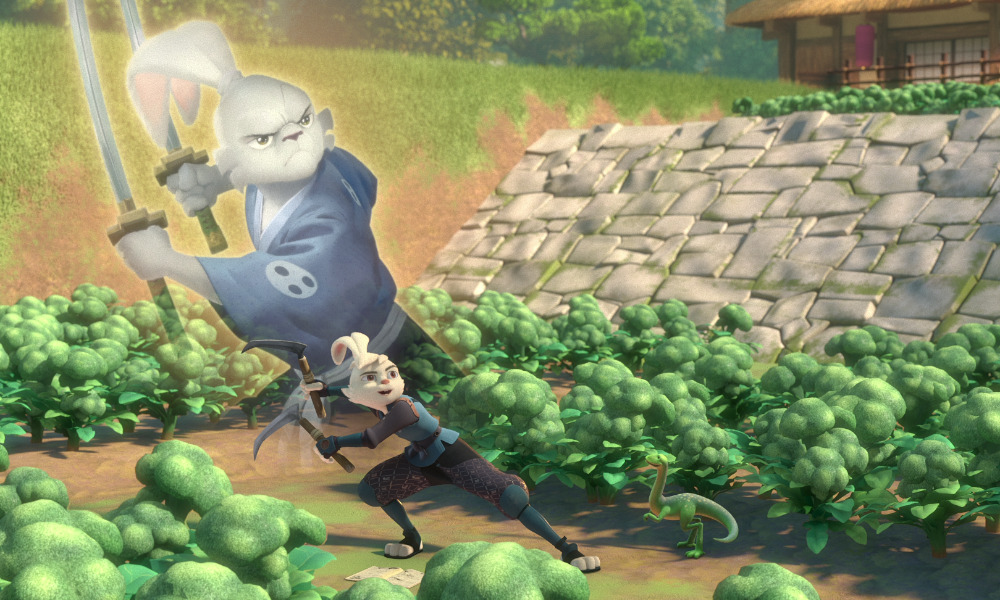***This article originally appeared in the May ’22 issue of Animation Magazine (No. 320)***
April is going to be a big month for fans of Usagi Yojimbo, the acclaimed 35-year-old comic-book series from award-winning creator Stan Sakai. That’s when Netflix and Gaumont’s new action-comedy, CG-animated adaptation Samurai Rabbit: The Usagi Chronicles premieres worldwide.
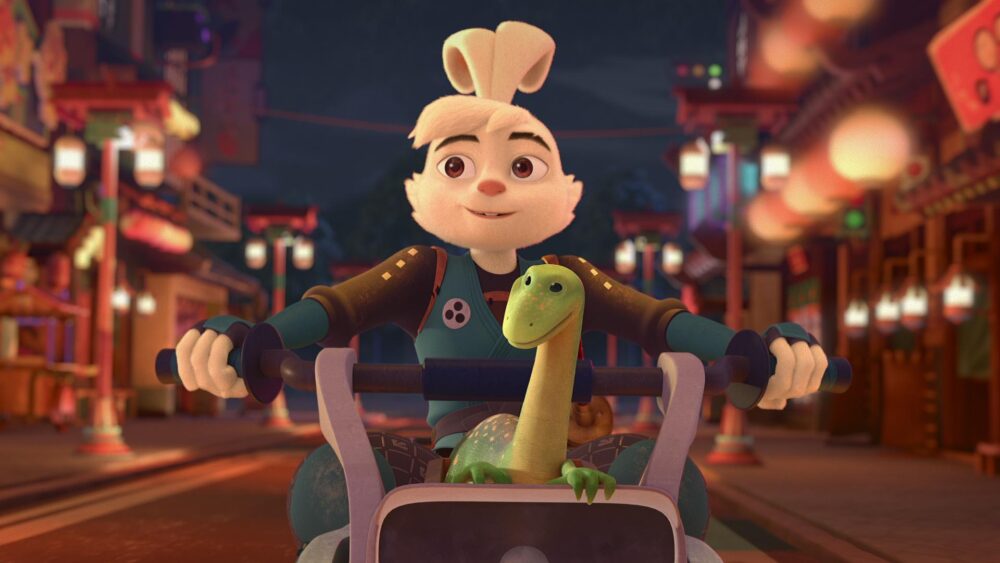
Taking place far in the future, the 10-episode series is set in a world that mixes sci-fi tech with magic and classic Japanese Edo-period culture. Samurai Rabbit follows the teenage Yuichi, descendent of the great early 17th century warrior Miyamoto Usagi, on his epic quest to become a true samurai. Along with his faithful pet lizard, Spot, the brash Yuichi (voiced by Darren Barnet) assembles a ragtag team of misfit heroes — including a roguish rhino bounty hunter named Gen (Aleks Le), a cunning ninja cat named Chizu (Mallory Low) and the acrobatic fox pickpocket Kitsune (Shelby Rabara) — as he battles depth-charging moles, metal-tipped winged bats and monsters from another dimension, all in the pursuit to become the best samurai usagi.
Samurai Rabbit is produced in partnership with Sakai, who also serves as executive producer, along with Gaumont, Dark Horse Entertainment and Atomic Monster. The series is written by executive producers Candie and Doug Langdale (Maya and the Three, The Book of Life, The Adventures of Puss in Boots, Kung Fu Panda: Legends of Awesomeness), with the visuals overseen by art director Khang Le (Big Hero 6: The Series, Little Big Awesome) and supervising producer Ben Jones (Batman vs. Teenage Mutant Ninja Turtles, Teen Titans, The Iron Giant). The animation is provided by Mumbai-based 88 Pictures (Trollhunters, 3Below: Tales of Arcadia, Fast & Furious: Spy Racers).
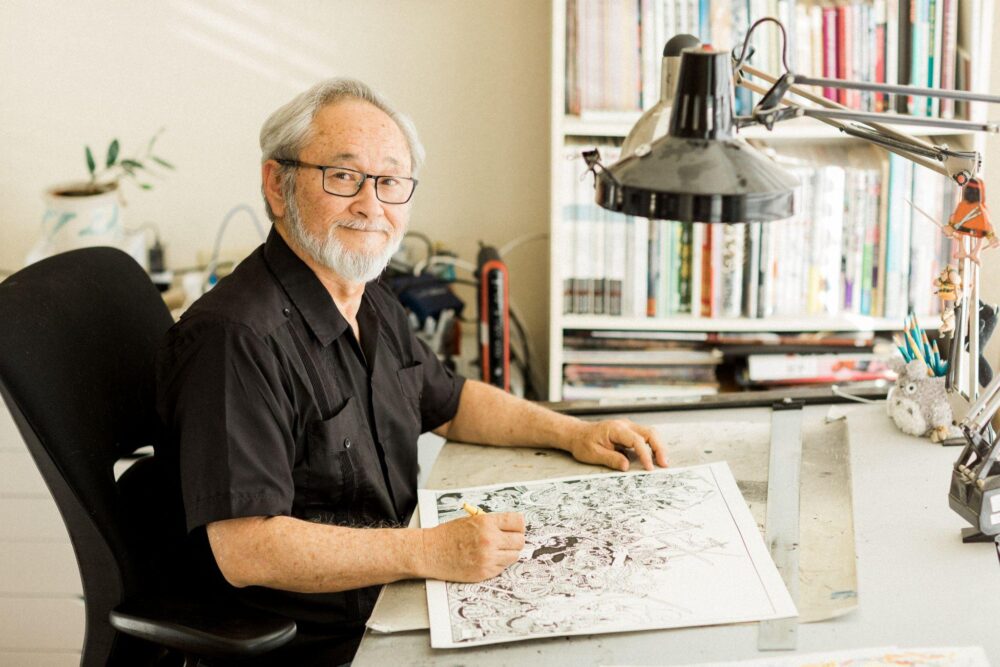
Living Legend
Sakai, who worked with Stan Lee for 25 years lettering the Spider-Man Sunday newspaper strips, is most famous for his original creation Usagi Yojimbo, an epic graphic novel saga that began in 1984 and now spans more than 34 volumes. The legendary creator, writer and illustrator has been honored with a number of awards for Usagi, among them six Eisner Awards, two Harvey Awards (including one for Best Cartoonist), the Japanese American National Museum’s Cultural Ambassador Award, a Parent’s Choice Award and an American Library Association Award.
“I have been doing Usagi since 1984, so it’s been more than 37 years,” says Sakai, explaining how protective he is about the property, which he fully owns. “I’d be very selective in bringing it to animation, other forms of media — but the experience has been great, and the show looks fantastic. The samurai culture in a future setting works just wonderfully. It’s just beautiful. The city looks like huge castles, and you have vehicles, but it has a lot of the feudal Japan feel to it.”

Initially skeptical about bringing Usagi into the future, Sakai was struck by Gaumont’s pitch and the early background and character designs. “I thought, ‘Oh my gosh, this will work.’ And it works. And it’s beautiful. The writers, Candie and Doug Langdale, did an amazing job with the storyline,” he says.
“My Usagi lives in feudal Japan, but we brought him into the storyline,” Sakai continues. “And there’s an incredible twist to my character that I just loved. So, they took my stories, but they also expanded on it and just went on much farther than I could have imagined.”
The Langdales, for their part, watched Akira Kurosawa films for inspiration, along with Japanese yōkai movies from the 1950s. “We were creating a world based on the world that Stan created for the Usagi Yojimbo books, but it’s a thousand years in the future from that time,” Doug Langdale says.
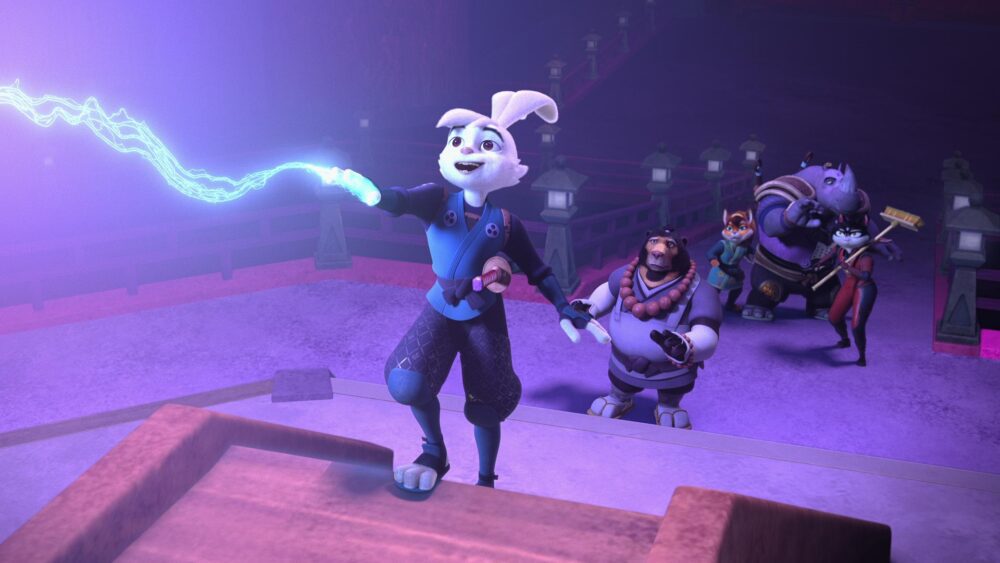
One major hurdle, the Langdales said, was creating a Japan-centric futuristic world. “The idea is that there hasn’t really been any influence in the future Japan in the series from other parts of the world,” Doug Langdale explained. “So trying to keep, as much as possible, western influences out of the look and feel of the world was a big challenge.”
To that end, there are no electronics — including smartphones and computers — in the world of Samurai Rabbit. “That came from high up,” Candie Langdale stated. “We were told not to do that. And we were like, ‘great.’ It makes the story more interesting with the challenges that that presents.”
Sakai was “very involved in every step of the process,” he says. “I approved everything. Everything came my way, from the initial plot outlines to character designs. I even approved things like the broccoli, and stones that were used for the background. And it was great, working with Netflix and Gaumont. It was a wonderful experience.”
Set in a sci-fi CGI universe, Samurai Rabbit also includes dynamic 2D sequences rendered in a gorgeous, hand-drawn style featuring Yuichi’s ancestor, Usagi. “Gaumont and I set about trying to make a different look between Yuichi’s futuristic world and my classic Usagi world,” Sakai says. “Whenever my Usagi appears, it’s a very different type of animation. You can immediately see that it’s either a flashback, a fantasy sequence or something very different. It’s a nice contrast, and it works great. I love the look of it.”

On Wisdom and Honor
Over the course of his quest, Yuichi learns not only what it takes to become a great samurai, but also more about his ancestor Usagi. “Yuichi idolizes his ancestor, and he himself wants to become a samurai, a great warrior,” Sakai recounts. “So he goes to the city, but things don’t go quite as smoothly as he had anticipated. He winds up with his band of misfits and together they encounter various yōkai, the monsters of Japanese mythology … Later, they act as a group, and it’s wonderful the way the characters develop, the way the entire group dynamic develops.”
Yuichi’s character arc is pronounced, as Sakai notes. “At first, he wants to fight,” he says. “That’s what he thinks a samurai should do. As the series progresses, he learns about himself. He learns about what it is to become a samurai, that it’s not just fighting. It’s about control. It’s about fighting, but what’s more important is not fighting. He has to learn when it’s appropriate and when it’s not. The fighting is never gratuitous. It’s a lot of fun. It’s never malicious. And I think Netflix and Gaumont handled it really well.”
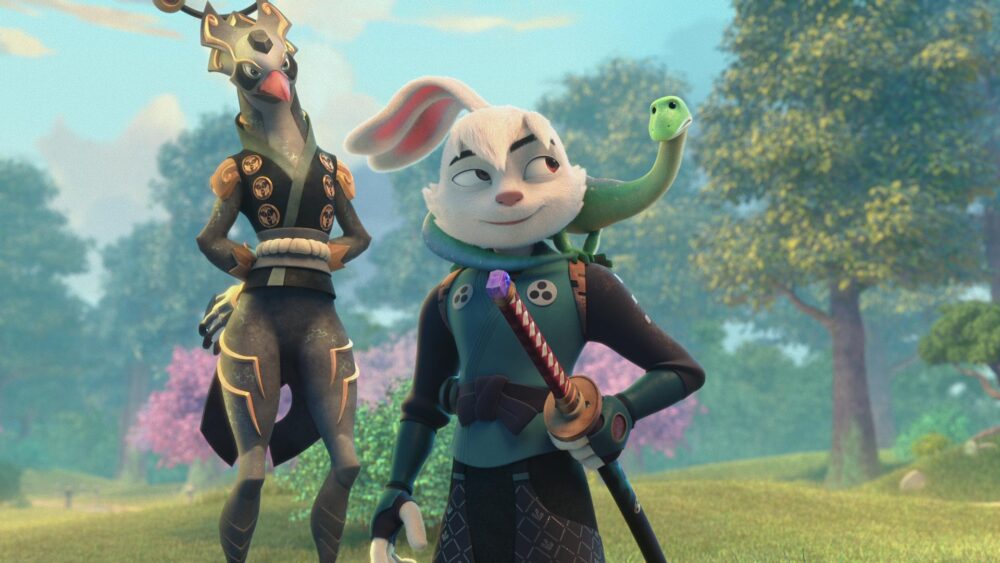
In early episodes, Yuichi “pretty much personifies the arrogance of youth,” Sakai says. “He thinks he knows it all. He thinks he’s so wonderful. He’s been given the sword, but he learns that there’s so much more that he needs to learn, that he has to develop. He has to grow as a person. Throughout the series, he not only matures, but he learns things about himself and what he’s capable of doing. He learns that too much arrogance is not good, that if he wants to be a leader, he has to control that — so that, rather than direct people, he inspires them.”
Asked what he hopes viewers will take away from Samurai Rabbit, Sakai recalls a conversation he once had with a mother of one of his readers. “Her son was reading a Usagi book, and she asked, ‘What’s it about?’ He thought for a second, and said, ‘It’s about honor.’ And I thought that was such a great answer. And that’s something that I would like people to take away with, is that this series is about honor. It’s about loyalty. It’s about friendship. And I think that’s a great message to leave with people.”
Samurai Rabbit: The Usagi Chronicles premieres on Netflix on April 28.





